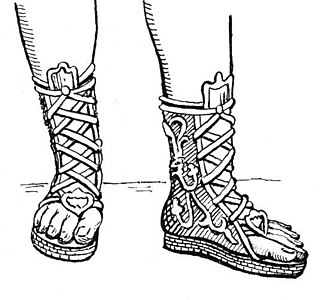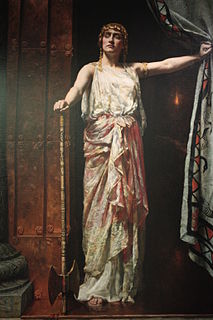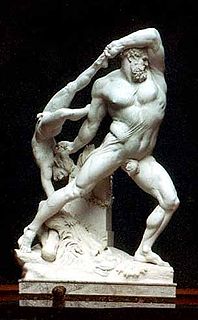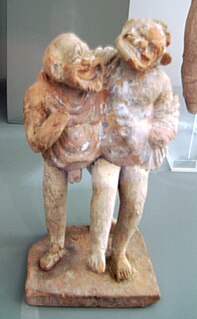A fabula crepidata or fabula cothurnata is a Latin tragedy with Greek subjects. The genre probably originated in adaptations of Greek tragedy (hence the names, coming from crepida = sandal and cothurnus ) beginning in the early third century B.C. Only nine have survived intact, all by Seneca. Of the plays written by Lucius Livius Andronicus, Gnaeus Naevius, Quintus Ennius, Marcus Pacuvius, Lucius Accius, and others, only titles, small fragments, and occasionally brief summaries are left. Ovid's Medea also did not survive.
Greek tragedy is a form of theatre from Ancient Greece and Asia Minor. It reached its most significant form in Athens in the 5th century BC, the works of which are sometimes called Attic tragedy. Greek tragedy is widely believed to be an extension of the ancient rites carried out in honor of Dionysus, and it heavily influenced the theatre of Ancient Rome and the Renaissance. Tragic plots were most often based upon myths from the oral traditions of archaic epics. In tragic theatre, however, these narratives were presented by actors. The most acclaimed Greek tragedians are Aeschylus, Sophocles and Euripides.

A buskin is a knee- or calf-length boot made of leather or cloth which laces closed, but is open across the toes. It was worn by Athenian tragic actors, hunters, and soldiers in Ancient Greek, Etruscan, and Roman societies.

Senecan tragedy refers to a set of ancient Roman tragedies. Ten of these plays exist, of which most likely eight were written by the Stoic philosopher and politician Lucius Annaeus Seneca. The group includes Hercules Furens, Medea, Troades, Phaedra, Agamemnon, Oedipus, Phoenissae, Thyestes, Hercules Oetaeus, and Octavia. Hercules Oetaeus is generally considered not to have been written by Seneca, and Octavia is certainly not. In the mid-16th century, Italian humanists rediscovered these works, making them models for the revival of tragedy on the Renaissance stage. The two great, but very different, dramatic traditions of the age—French neoclassical tragedy and Elizabethan tragedy—both drew inspiration from Seneca. Usually, the Senecan tragedy focuses heavily on supernatural elements.
This page is based on this
Wikipedia article Text is available under the
CC BY-SA 4.0 license; additional terms may apply.
Images, videos and audio are available under their respective licenses.

Gaius Plinius Caecilius Secundus, born Gaius Caecilius or Gaius Caecilius Cilo, better known as Pliny the Younger, was a lawyer, author, and magistrate of Ancient Rome. Pliny's uncle, Pliny the Elder, helped raise and educate him.

Tragedy is a form of drama based on human suffering that invokes an accompanying catharsis or pleasure in audiences. While many cultures have developed forms that provoke this paradoxical response, the term tragedy often refers to a specific tradition of drama that has played a unique and important role historically in the self-definition of Western civilisation. That tradition has been multiple and discontinuous, yet the term has often been used to invoke a powerful effect of cultural identity and historical continuity—"the Greeks and the Elizabethans, in one cultural form; Hellenes and Christians, in a common activity," as Raymond Williams puts it.

Plot refers to the sequence of events inside a story which affect other events through the principle of cause and effect. The causal events of a plot can be thought of as a series of sentences linked by the connector "and so". Plots can vary from simple structures—such as in a traditional ballad—to complex interwoven structures sometimes referred to by the term imbroglio. The term plot can also serve as a verb referring to a character planning future actions in the story.

Seneca the Younger (c. 4 BC – AD 65), fully Lucius Annaeus Seneca and also known simply as Seneca, was a Roman Stoic philosopher, statesman, dramatist, and—in one work—satirist of the Silver Age of Latin literature.

Lucius Livius Andronicus was a Greco-Roman dramatist and epic poet of the Old Latin period. He began as an educator in the service of a noble family at Rome by translating Greek works into Latin, including Homer's Odyssey. They were meant at first as educational devices in the school he founded. He wrote works for the stage—both tragedies and comedies—which are regarded as the first dramatic works written in the Latin language of ancient Rome. His comedies were based on Greek New Comedy and featured characters in Greek costume. Thus, the Romans referred to this new genre by the term comoedia palliata. The Roman biographer Suetonius later coined the term "half-Greek" of Livius and Ennius. The genre was imitated by the next dramatists to follow in Andronicus' footsteps and on that account he is regarded as the father of Roman drama and of Latin literature in general; that is, he was the first man of letters to write in Latin. Varro, Cicero, and Horace, all men of letters during the subsequent Classical Latin period, considered Livius Andronicus to have been the originator of Latin literature. He is the earliest Roman poet whose name is known.
Gaius Julius Caesar Strabo Vopiscus (ca. 130 BC – 87 BC) was the younger son to Lucius Julius Caesar II and his wife Poppilia and younger brother to Lucius Julius Caesar III. His cognomina indicate he was possibly cross-eyed, and the surviving member of a set of twins.
The praetexta or fabula praetexta was a genre of Latin tragedy introduced at Rome by Gnaeus Naevius in the third century B.C. It dealt with historical Roman figures, in place of the conventional Greek myths. Subsequent writers of praetextae included Ennius, Pacuvius and Lucius Accius. The name refers to the toga praetexta, the official dress of Roman magistrates.
The Milesian tale is a genre of fictional story prominent in ancient Greek and Roman literature. According to most authorities, a Milesian tale is a short story, fable, or folktale featuring love and adventure, usually of an erotic or titillating nature. M. C. Howatson, in The Oxford Companion to Classical Literature (1989), voices the traditional view the Milesian tale is the source "of such medieval collections of tales as the Gesta Romanorum, the Decameron of Boccaccio, and the Heptameron of Marguerite of Navarre".

Drama is the specific mode of fiction represented in performance: a play, opera, mime, ballet, etc, performed in a theatre, or on radio or television. Considered as a genre of poetry in general, the dramatic mode has been contrasted with the epic and the lyrical modes ever since Aristotle's Poetics —the earliest work of dramatic theory.

Thyestes is a first century AD fabula crepidata of approximately 1112 lines of verse by Lucius Annaeus Seneca, which tells the story of Thyestes, who unwittingly ate his own children who were slaughtered and served at a banquet by his brother Atreus. As with most of Seneca's plays, Thyestes is based upon an older Greek version with the same name by Euripides.

Agamemnon is a fabula crepidata of c. 1012 lines of verse written by Lucius Annaeus Seneca in the first century AD, which tells the story of Agamemnon, who was killed by his wife Clytemnestra in his palace after his return from Troy.

Phoenissae is a fabula crepidata written by Lucius Annaeus Seneca; with only c. 664 lines of verse it is his shortest play. It is an incomplete text in two parts. It is situated in Thebes in Boeotia, the city founded by Cadmus, who came from Sidon, in Phoenicia.

Troades is a fabula crepidata of c. 1179 lines of verse written by Lucius Annaeus Seneca.

Hercules or Hercules furens is a fabula crepidata of c. 1344 lines of verse written by Lucius Annaeus Seneca.

Hercules Oetaeus is a fabula crepidata of c. 1996 lines of verse which survived as one of Lucius Annaeus Seneca's tragedies. It tells the story of Hercules' betrayal by his jealous wife, Deianira, followed by his death and apotheosis. The general opinion is that the play is not Seneca's, but was written in close imitation.













